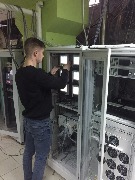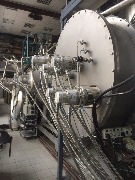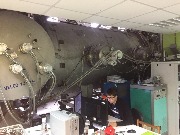On a Way to High Orbit: MAI Researchers Develop Space Thrusters
The MAI Research Institute of Applied Mechanics and Electrodynamics (Ion Propulsion Center) in cooperation with other MAI departments develops electric propulsion thrusters for spacecraft.
Scientists do experiments with different models of Hall-effect thrusters which had been primarily invented and put into series in Russia a few decades ago. They also investigate high-frequency ion thrusters (also known as radio-frequency ion thrusters) and pulsed plasma thrusters. All these types of thrusters are commonly known as ion thrusters.
Ion thrusters are usually installed on spacecraft for providing orbital maneuvers, orbit insertions for getting geostationary orbit, and long-distance space flights. They have high specific impulse combined with little fuel input, which makes them very efficient for long-term space missions.
Today, Moscow Aviation Institute has close university-industry partnerships with industry leaders: Experimental Design Bureau FAKEL, Chemical Automatics Design Bureau, Energia corporation, VNIIEM corporation, TsNIIMash Science Center.
At the same time, MAI has its own fully equipped laboratory center for testing and scrutinizing thrusters’ operations in a vacuum. Science fellows from Faculty of Propulsion Engineering, Faculty of Control Systems, Computer Science and Power Engineering, Faculty of Electronics of Flight Vehicles, Faculty of Aerospace Engineering, and Faculty of Robotics and Artificial Intelligence Systems actively participate in the research works of the Ion Propulsion Center.
A modern testing site aimed at examining the functioning of ion thrusters is deployed at the Center. The experiments allow modeling the ballistics of spacecraft equipped with ion thrusters.
The activity of the Center has been highly recognized in Russia as well as abroad.

Sustainable Partnership
MAI Ion Propulsion Center and EDB FAKEL have been developing Hall-effect thrusters for several decades. They are commonly installed on large satellites with a mass of more than 1 ton and remain functional for many years. Up to 8 such ones can be installed on a spacecraft.
For example, the geostationary satellite Yamal-202 equipped with Hall-effect ion thrusters was launched on November 24, 2003, and is still in service.
ISS-Reshetnev Company, RSC Energia, and VNIIEM Corporation, as well as other international majors, are the principal customers of these drives.
At High Frequency
In 2010, a new laboratory aimed at studying high-frequency ion thruster was opened at MAI. The laboratory was headed by Prof. Horst Wolfgang Loeb who previously worked at Giessen University and was acknowledged as the inventor of high-frequency ion thrusters.
“Under his leadership, MAI specialists have made a breakthrough in the study and improvement of this type of thruster,” - said Ruslan Akhmetzhanov , science fellow of the Center, – “our young scientists got an excellent opportunity to study an alternative approach to the design of ion thrusters.”
In collaboration with Chemical Automatics Design Bureau scientists designed, created and tested a new model of high-frequency ion thruster.
In recent years, the number of small satellites being launched has been rapidly growing. They usually fly on low earth orbits (LEO) experiencing very rapid orbital decay and altitude loss due to atmospheric drag. That’s why such satellites need to be equipped with light and compact drivers like high-frequency ion thruster.
“A thruster we created aimed at operating on spacecraft with weight from 150 kg to 500 kg. Its power consumption is only about 300 watts. The thruster utilizes xenon gas as propellant having the exhaust velocity of 35-40 kilometers per second that is an order of magnitude higher than exhaust velocity of liquid-propellant rocket engines,”- explained Ruslan Akhmetzhanov.He highly recognized the contribution of specialists from Faculty of Electronics of Flight Vehicles who created a control system module for the thruster and the colleagues from Keldysh Research Center who supplied the device with fuel consumption control module and neutralizing electron gun. The collaboration between MAI Research Institute of Applied Mechanics and Electrodynamics and Chemical Automatics Design Bureau actively continues today.



